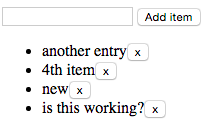Deleting item using Ajax request with DELETE and OPTIONS
We can now add new elements and list the existing elements from our list of items, but how can we delete an element?
For this we need another ajax request that will send in the ID of the item. For that we'll have to create a button on the HTML page that already has this ID. Before doing the front-end though, let's add the API call for deleting an item.
I could send another GET request for this, but if I understand REST correctly, this operation should be a DELETE request.
Travis-CI
Before going on I wanted to turn on Travis-CI for Continuous Integration and testing in two commits: commit 1 and commit 2
branches:
except:
- gh-pages
language: perl
perl:
- "5.20"
- "5.18"
- "5.16"
- "5.14"
- "5.12"
- "5.10"
before_install:
- cpanm --notest MongoDB
services:
- mongodb
Check out the post of Neil Bowers for more details on how to set up Travis-CI.
Refactoring the code
Then, before I implemented the DELETE feature I felt I have to do a little refactoring. We had two places where we connected to MongoDB and accessed the collection. I wanted to unite them and hide them in a single function. Hence I created the _mongodb function:
sub _mongodb {
my ($collection) = @_;
my $client = MongoDB::MongoClient->new(host => 'localhost', port => 27017);
my $db = $client->get_database( config->{app}{mongodb} );
return $db->get_collection($collection);
}
and in the two places where it was used, I replaced the same code snippet with a call to
my $items = _mongodb('items');
The back-end in Dancer
Dancer supports the implementation of the DELETE HTTP method, but instead of using the delete word, which is an existing built-in function in perl, it used the del keyword.
Here we expect that the client will send in a url that looks like this: /api/v2/item/913397349743, the last part being the OID of the object in the MongoDB. In MongoDB every document has a unique ID in the _id field. If we don't supply one, MongodDB will create one for us. If you recall in the earlier articles when we wrote the tests, we had to disregard these ids, because they are totally unpredictable and they change from test-run to test-run.
The param function of Dancer will return the string that was the last part of that URL which is expected to be the ID.
Then we call _mongodb('items') that we have just created with the refactoring and we call the remove method passing the filter that will locate the document with the specific ID.
After that we return a hash reference indicating success.
As far as I understood, the current MongoDB driver for Perl won't be able to tell if there was anything deleted or if the supplied ID did not match anything, though we could add some more robust error reporting. For now I think we'll live with this code.
lib/D2/Ajax.pm
del '/api/v2/item/:id' => sub {
my $id = param('id');
my $items = _mongodb('items');
$items->remove({ _id => MongoDB::OID->new($id) });
my $json = JSON::MaybeXS->new;
return to_json { ok => 1 };
};
Testing the API
Implementing the API without any test would not be full, so I edited t/v2.t and added the following code to the v2_items subtest:
my @items = ("One 1", "Two 2", "Three 3");
foreach my $it (@items) {
my $res = $test->request( POST '/api/v2/item', { text => $it });
is_deeply decode_json($res->content), { ok => 1, text => $it };
}
my $get5 = $test->request( GET '/api/v2/items');
my $items5 = decode_json($get5->content);
is scalar @{$items5->{items}}, 5;
my $del3 = $test->request( DELETE '/api/v2/item/' . $items5->{items}[3]{'_id'}{'$oid'} );
is $del3->content, '{"ok":1}';
my $get6 = $test->request( GET '/api/v2/items');
my $items6 = decode_json($get6->content);
is scalar @{$items6->{items}}, 4;
is_deeply $items5->{items}[0], $items6->{items}[0];
is_deeply $items5->{items}[1], $items6->{items}[1];
is_deeply $items5->{items}[2], $items6->{items}[2];
is_deeply $items5->{items}[4], $items6->{items}[3];
is_deeply $items5->{items}[5], $items6->{items}[4];
At first this code adds 3 more items checking if they were added successfully. Then it sends a "DELETE" request using the ID of the 4th element (index 3) and checks if the returned JSON string represents the expected { ok => 1 } data structure from Perl.
Then we fetch the list of items again, check if there are only 4 left and check if the 4 that were left match the 4 we expected to be there. (Without the element we have deleted.)
This was not enough to run the tests though. Apparently HTTP::Request::Common exports GET and POST automatically, but if we also want to use DELETE we need to ask for it. Hence we also had to change the use-statement at the top of the test script to be:
use HTTP::Request::Common qw(GET POST DELETE);
After updating the "test plan" as well, the test ran successfully.
Client side for DELETE-ing
Then I set out to implement the client-side code for deleting an item. The first thing I had to do is to add a "delete" button next to each item that will also hold the ID of that item. Luckily the Ajax request that retrieves the list of items also sends over the ID of each item. We can modify the HTML we generate to include a button:
This is the new code:
for (i = 0; i < data["items"].length; i++) {
html += '<li>' + data["items"][i]["text"] + '<button class="delete" data-id="' + data["items"][i]["_id"]["$oid"] + '">x</a></li>';
}
This will add a button element at the end of each item with two attributes. One of them is class="delete" will make it easy to locate all the delete buttons, the other one data-id="...."> holds the id of the current element.
It will look like this:

Once the new HTML is injected in the existing page we also call
$(".delete").click(delete_item);
this will attach the delete_item function to each on of the buttons that are in the "delete" class.
The new code generating the HTML looks like this:
function show_items() {
jQuery.get('http://127.0.0.1:5000/api/v2/items', function(data) {
var i, html;
html = '<ul>';
console.log(data);
for (i = 0; i < data["items"].length; i++) {
html += '<li>' + data["items"][i]["text"] + '<button class="delete" data-id="' + data["items"][i]["_id"]["$oid"] + '">x</a></li>';
}
html += '</ul>';
$("#items").html(html);
$(".delete").click(delete_item);
});
}
Now we only need to implement the delete_item function:
function delete_item() {
var id = $(this).attr('data-id');
jQuery.ajax({
url: 'http://127.0.0.1:5000/api/v2/item/' + id,
type: 'DELETE',
success: function(data) {
show_items();
}
});
}
It is a simple Ajax call just like the get and the post calls we saw earlier, but jQuery does not have the nice syntactic sugar for sending a delete request and thus we had to write a few more lines. Nevertheless, here too we have a call-back that will be executed once the server replied. The only thing the callback does is calling the show_items function. Actually I could have written success: show_items as well.
It was time to try it in the browser. I loaded the page, and clicked on one of the x buttons and nothing happened.
Looking at the console I saw this error:
XMLHttpRequest cannot load http://127.0.0.1:5000/api/v2/item/556db39fa114604bac0757d1. No 'Access-Control-Allow-Origin' header is present on the requested resource. Origin 'null' is therefore not allowed access. The response had HTTP status code 404.
This baffled me for quite some time, after all I've already fixed the Access-Control-Allow-Origin issue.
Looking at the error message more could have given me a clue, but it didn't. The clue would been the fact the I also had The response had HTTP status code 404. which means the server could not find the route and returned a 404 which does not have the Access-Control-Allow-Origin header.
There was also another clue I missed. In the console, just before this error, there was another error:
OPTIONS http://127.0.0.1:5000/api/v2/item/556db39fa114604bac0757d1
which shows that jQuery, instead of sending the DELETE request, it sends an OPTIONS request.
That was not enough for me. I looked at the console where I run the plackup -R lib bin/app.psgi which said, among many other things:
looking for options /api/v2/item/556db39fa114604bac0757d1
That further confused me. Why is Dancer looking for the "options" HTTP method while I requested the "delete" method?
Apparently this is due to some safety feature of Chrome when using cross domain requests. If in a cross-domain request we ask for anything else than basic GET or POST, Chrome will first send an "OPTIONS" request to the same URL and will look for the Access-Control-Allow-Methods header that needs to list the HTTP methods the server will accept. The content of the response of that request can be empty, just the header needs to be set. So I added
header 'Access-Control-Allow-Methods' => 'GET, POST, OPTIONS, DELETE';
to the before hook so it will send it on every request in the v2 API, and I've also added a route:
options '/api/v2/item/:id' => sub {
return '';
};
After that the "delete" buttons started to function as I expected.
Updating the tests
Now both the client work and our tests are still passing, but I think I'd better update the tests to check the latest changes to the back-end code.
I've added the test code:
my $options = $test->request( OPTIONS '/api/v2/item/anything' );
ok $options->is_success, '[POST /] successful';
is $options->header('Access-Control-Allow-Methods'), 'GET, POST, OPTIONS, DELETE';
and wanted to import the OPTIONS method from HTTP::Request::Common,
but apparently it does not support it. There is even an open ticket from 2011.
For now I am going to leave the test in, commented out and include the link to the ticket. Later we might revisit the issue.
Hello, sir I try to delete the product id from session, it already deleted the data, but I still have problem that the data is still keep the old data until we click to other pages that it will not show on the view page. How make it smoothly to get new data after we deleted?
function clearCart()
{
var msgClear = confirm ("Are you sure you want to clear carts list?");
if (msgClear) {
$.ajax({
type: "POST",
url: "",
data: "",
success: function (response) {
alert(response);
}
});
}
}
Comments

Published on 2016-07-29
